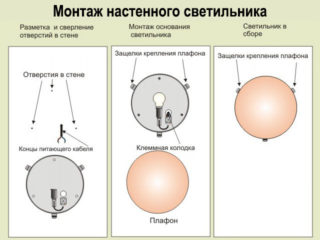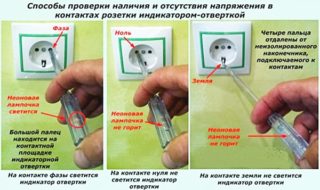The organization of the correct lighting system includes several stages. These include the calculation of the required number of bulbs, the choice of lighting devices, as well as their installation. Different types of luminaires are attached to the surface in their own way, and this must be taken into account when purchasing and installing. The creation of a scheme for the installation of lighting devices is carried out even before the start of a major overhaul, so it is important to think over all the nuances of placement in advance.
What determines the choice of the method of mounting the fixtures
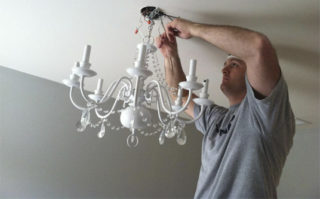
Installation of lighting devices is a simple process. Even someone who has never worked with an electrician can figure out the basics and get the job done. The main thing is to carefully and accurately perform all the steps and observe safety precautions.
Lighting devices differ in different ways. They can be mounted on different surfaces (walls, ceilings, placed on a table or on the floor), built-in and external. The complexity of the process depends on all these points.
The easiest products to install are wall-mounted luminaires. They are securely attached to the walls with fasteners (usually dowels). It is important to consider the wire size when installing. Its length must be such that the lighting device can be powered from the nearest socket.
Ceiling products are somewhat more difficult to mount. Before installing the ceiling luminaire on the ceiling, you need to hang a special fastener. For suspended models, this is a hook that fits into the back box. Also, metal platforms are actively used, on which the chandelier is attached.
If built-in lamps are used, a hole must be made in the canvas in advance to fix them.
Preparatory work
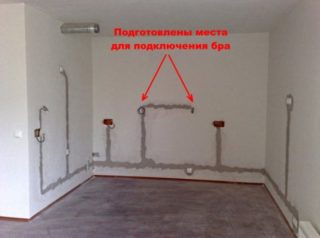
Most of the electrical work is done before wallpapering and decorative plastering. The master must do the following manipulations:
- Choose a lighting device in advance. It is important to take into account the microclimate of the room and its purpose. In the bathroom, you should buy devices with protection against moisture, in the living room and bedroom, ordinary lamps and chandeliers will do. At the same stage, the types of lighting devices are selected. These can be incandescent, halogen, LED or fluorescent devices.
- Choose a place to install the lighting device. It depends on the purpose of the lamp, its size, the type of room, the ability to connect to a power point and other indicators.
- Cut through ducts for routing cables to the installation site.
You should also calculate the number of fixtures for the room in advance. It depends on the area of the room, its purpose and other parameters.
Installation of various types of mounts
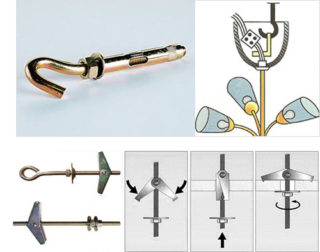
Since the greatest difficulty is caused by fixing to the ceiling, they need to be dealt with more carefully.
There are situations when there is no installation box for wall lamps in the room. You can fix the metal plate to the surface in the following ways:
- Screw the plate to the ceiling using self-tapping screws onto a wooden block. The beam must be placed in the hole in the ceiling.
- Make several holes on the ceiling surface.They must be positioned so that they line up with the holes in the mounting plate. When the holes are made, you need to attach a plate to the ceiling and fix it with dowels.
In a similar way, a hook can be attached to which the chandelier is suspended.
Wall lights
Devices on the wall are connected depending on the circuit used. They can be divided into two groups - with a toggle switch built into the body and with an external switch. The first category includes decorative structures in the form of wall sconces and ceiling lamps installed in furniture. The second type includes products for lighting auxiliary rooms (pantry, corridor, hallway, kitchen). The main advantage of such devices is ease of installation and dismantling.
Algorithm for installing wall lighting:
- Mounting points on the wall. To do this, you need to attach the body to the wall and make marks where the fasteners will be.
- Fixing the lamp. It is done with dowels or on a bracket or other supporting structure. The second method is suitable for massive structures.
- Installing a light bulb in the socket.
- Functional check.
The correct location of the luminaire depends on the accuracy of the marking of the rear part. There is usually a small gap on the mounts, so the position can be adjusted if the location is chosen with a slight discrepancy.
Next, the wires are connected. The zero always goes directly and the phase goes through the switch if the switch model is selected. Before connecting the wires, you should check what the specific core is responsible for. This can be done using an indicator screwdriver or a multimeter.
Connecting built-in lights
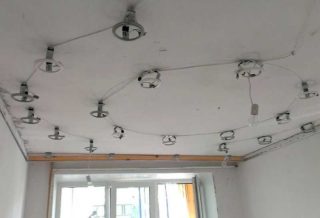
The technology of mounting recessed luminaires differs from classic wall and ceiling lamps by the presence of an additional power supply. It also plays a protective role.
Installation of recessed luminaires is carried out as follows:
- Determination of the installation site. Creation of a wiring diagram and a power supply.
- Laying cables.
- Cutting a hole in the canvas of a suspended or stretch ceiling of a certain diameter for a luminaire.
- Pulling the wires out through the hole.
- Connecting wires and installing fixtures in the mounting hole.
- Functional check.
The massive structures are fixed to a steel rack frame even before the ceiling tiles are assembled. Then the lamp is dismantled, in its place a transitional mount remains. When drywall or MDF boards are laid, mark the position of the case on the canvas, make a corresponding hole and make further connections.
Preparing the lighting fixture for installation
Before installing the luminaire, you need to carefully check it for the level of assembly quality. If the bolted connections are weak, they must be tightened. Holders, contacts and conductor connections should also be inspected and corrected if necessary. If chips, burnt parts, debris are found, disassemble and replace the part with a new and functional one. It is dangerous to use a defective product.
It is recommended to purchase wall lighting and components only from professional stores. Otherwise, there is a risk of buying counterfeit products that will not meet the declared characteristics. To save energy, it is better to buy and install energy-saving lamps. These include fluorescent and LED devices.
Safety engineering
- All work is carried out only when the electricity is off. It can be switched off in the input distribution board.
- You need to make sure that there is no current on the wires. This can be done using an indicator.If there is a residual voltage, you need to wait until the residual current passes. If voltage is detected during repeated checks, contact an electrician.
- For work, the master will need personal protective equipment - dielectric gloves and glasses.
- When installing the luminaire on the ceiling, you will need a stable ladder or stepladder.
- You need to prepare an autonomous light source in advance. This can be a battery-powered forehead flashlight or an external light source.
- All tools must be in good working order and have insulated handles.
Compliance with the listed simple rules will help the master to protect himself and not get damaged by electric shock.

